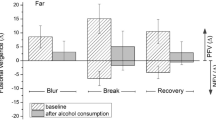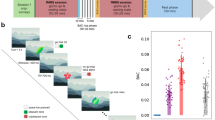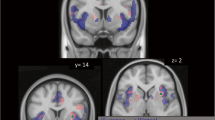Abstract
Driving while intoxicated is a major public health problem. We investigated impaired driving using a simulated driving skill game that presents an ‘in-car’ view of a road and a readout of speed. We explored brain activation and behavioral alterations from baseline at two blood alcohol concentrations (BACs). Participants received single-blind individualized doses of beverage alcohol designed to produce blood alcohol content (BAC) of 0.04 and 0.08 or placebo. Scanning occurred on a 1.5 Tesla Philips MRI scanner after training to asymptote performance. Analysis was performed using independent component analysis (ICA) to isolate systematically nonoverlapping ‘networks’ and their time courses. Imaging results revealed seven separate driving-related brain networks with different time courses. Several significant findings were observed for the imaging data. First, dose-dependent functional magnetic resonance imaging (fMRI) changes were revealed in orbitofrontal (OF) and motor (but not cerebellar) regions; visual and medial frontal regions were unaffected. Second, cerebellar regions were significantly associated with driving behavior in a dose-dependent manner. Finally, a global disruptive effect of alcohol on the ICA time courses was observed with highly significant differences in OF and motor regions. Alcohol thus demonstrated some behavioral effects and unique, disruptive, dose-dependent effects on fMRI signal within several brain circuits. The fMRI data also suggest that the deficits observed in alcohol intoxication may be modulated primarily through OF/anterior cingulate, motor and cerebellar regions as opposed to attentional areas in frontoparietal cortex.
Similar content being viewed by others
Log in or create a free account to read this content
Gain free access to this article, as well as selected content from this journal and more on nature.com
or
References
Arnedt JT, Wilde GJ, Munt PW, MacLean AW (2001). How do prolonged wakefulness and alcohol compare in the decrements they produce on a simulated driving task? Accid Anal Prev 33: 337–344.
Bell AJ, Sejnowski TJ (1995). An information maximisation approach to blind separation and blind deconvolution. Neural Comput 7: 1129–1159.
Biswal BB, Ulmer JL (1999). Blind source separation of multiple signal sources of fMRI data sets using independent component analysis. J Comput Assist Tomogr 23: 265–271.
Calhoun VD, Adali T, Kraut M, Pearlson GD (2000). A weighted-least squares algorithm for estimation and visualization of relative latencies in event-related functional MRI. Magn Res Med 44: 947–954.
Calhoun VD, Adali T, Pearlson GD, Pekar JJ (2001a). A method for making group inferences from functional MRI data using independent component analysis. Hum Brain Mapp 14: 140–151.
Calhoun VD, Adali T, Pearlson GD, Pekar JJ (2001b). Spatial and temporal independent component analysis of functional MRI data containing a pair of task-related waveforms. Hum Brain Mapp 13: 43–53.
Calhoun VD, Altschul D, McGinty V, Shih RA, Scott D, Pearlson GD (2004). Alcohol intoxication effects on visual perception: an fMRI study. Neuroimage 21: 15–26.
Calhoun VD, Pekar JJ, McGinty VB, Adali T, Watson TD, Pearlson GD (2002). Different activation dynamics in multiple neural systems during simulated driving. Hum Brain Mapp 16: 158–167.
Deery HA, Fildes BN (1999). Young novice driver subtypes: relationship to high-risk behavior, traffic accident record, and simulator driving performance. Hum Factors 41: 628–643.
Duann JR, Jung TP, Kuo WJ, Yeh TC, Makeig S, Hsieh JC et al (2002). Single-trial variability in event-related BOLD signals. Neuroimage 15: 823–835.
Electronic Arts I (1998). Need for Speed II.
Genovese CR, Lazar NA, Nichols T (2002). Thresholding of statistical maps in functional neuroimaging using the false discovery rate. Neuroimage 15: 870–878.
Groeger J (2000). Understanding Driving: Applying Cognitive Psychology to a Complex Everyday Task. Psychology Press: New York.
Hammersley R, Finnigan F, Millar K (1992). Alcohol placebos: you can only fool some of the people all of the time. Br J Addict 87: 1477–1480.
Hindmarch I, Kerr JS, Sherwood N (1991). The effects of alcohol and other drugs on psychomotor performance and cognitive function. Alcohol Alcohol 26: 71–79.
Holmes AP, Friston KJ (1998). Generalizability, random effects, and population inference. Neuroimage 7: S754.
Janca A, Ustun TB, Sartorius N (1994). New versions of World Health Organization instruments for the assessment of mental disorders. Acta Psychiatr Scand 90: 73–83.
Kapur BM (1989). Computer Blood Alcohol Calculator v1.20 ARF Software. Addiction Research Foundation: Toronto, Canada.
Levin JM, Ross MH, Mendelson JH, Kaufman MJ, Lange N, Maas LC et al (1998). Reduction in BOLD fMRI response to primary visual stimulation following alcohol ingestion. Psychiatry Res 82: 135–146.
Linnoila M, Mattila MJ (1973). Interaction of alcohol and drugs on psychomotor skills as demonstrated by a driving simulator. Br J Pharmacol 47: 671P–672P.
Mascord D, Walls J, Starmes G (1995). In: Hartley L (ed). Fatigue and Driving: Driver Impairment, Driver Fatigue, and Driving Simulation. Taylor & Francis: London. pp 189–205.
McGinty VB, Shih RA, Garrett ES, Calhoun VD (2001). Assessment of intoxicated driving with a simulator: a validation study with on road driving. Proceedings of the Human Centered Trans Sim Conference. Iowa City, IA. p 11.
McKeown MJ, Makeig S, Brown GG, Jung TP, Kindermann SS, Bell AJ et al (1998). Analysis of fMRI data by blind separation into Independent spatial components. Hum Brain Mapp 6: 160–188.
Mitchell MC (1985). Alcohol-induced impairment of central nervous system function: behavioral skills involved in driving. J Stud Alcohol Suppl 10: 109–116.
Mongrain S, Standing L (1989). Impairment of cognition, risk-taking, and self-perception by alcohol. Percept Mot Skills 69: 199–210.
Moskowitz H, Sharma S (1974). Effects of alcohol on peripheral vision as a function of attention. Hum Factors 16: 174–180.
National Highway Traffic Safety Administration (2002). DOT HS 809 606.
Neill RA, Delahunty AM, Fenelon B (1991). Discrimination of motion in depth trajectory following acute alcohol ingestion. Biol Psychol 31: 1–22.
Ogawa S, Lee TM, Kay AR, Tank DW (1990). Brain magnetic resonance imaging with contrast dependent on blood oxygenation. Proc Natl Acad Sci 87: 9868–9872.
Peterson JB, Rothfleisch J, Zelazo PD, Pihl RO (1990). Acute alcohol intoxication and cognitive functioning. J Stud Alcohol 51: 114–122.
Ridderinkhof KR, de Vlugt Y, Bramlage A, Spaan M, Elton M, Snel J et al (2002). Alcohol consumption impairs detection of performance errors in mediofrontal cortex. Science 298: 2209–2211.
Rimm DC, Sininger RA, Faherty JD, Whitley MD, Perl MB (1982). A balanced placebo investigation of the effects of alcohol vs. alcohol expectancy on simulated driving behavior. Addict Behav 7: 27–32.
Schmithorst VJ, Holland SK (2004). Comparison of three methods for generating group statistical inferences from independent component analysis of functional magnetic resonance imaging data. J Magn Reson Imaging 19: 365–368.
Talairach J, Tournoux P (1988). A Co-Planar Sterotaxic Atlas of a Human Brain. Thieme: Stuttgart.
van de Moortele PF, Cerf B, Lobel E, Paradis AL, Faurion A, Le Bihan D (1997). Latencies in fMRI time-series: effect of slice acquisition order and perception. NMR Biomed 10: 230–236.
Verster JC, Volkerts ER, Verbaten MN (2002). Effects of alprazolam on driving ability, memory functioning and psychomotor performance: a randomized, placebo-controlled study. Neuropsychopharmacology 27: 260–269.
Voas RB, Tippetts AS (1999). DOT HS 808 980.
Volkow ND, Mullani N, Gould L, Adler SS, Guynn RW, Overall JE et al (1988). Effects of acute alcohol intoxication on cerebral blood flow measured with PET. Psychiatry Res 24: 201–209.
Walter H, Vetter SC, Grothe J, Wunderlich AP, Hahn S, Spitzer M (2001). The neural correlates of driving. Neuroreport 12: 1763–1767.
Weiler JM, Bloomfield JR, Woodworth GG, Grant AR, Layton TA, Brown TL et al (2000). Effects of fexofenadine, diphenhydramine, and alcohol on driving performance. A randomized, placebo-controlled trial in the Iowa driving simulator. Ann Intern Med 132: 354–363.
Worsley KJ, Friston KJ (1995). Analysis of fMRI time-series revisited—again. Neuroimage 2: 173–181.
Acknowledgements
We thank Dave Altschul, Vince McGinty, Dave Scott, Mohammed Shaikh, Heather Strasser, Regina Shih, and Todd Watson for help with data collection. Data were acquired at the FM Kirby Research Center for Functional Brain Imaging, Kennedy Krieger Institute. This work was supported by the National Institutes of Health under Grant 1 R01 EB 000840-01 (to VC), by an Outpatient Clinical Research Centers Grant M01-RR00052 (to GP), and by P41 RR 15241.
Author information
Authors and Affiliations
Corresponding author
Rights and permissions
About this article
Cite this article
Calhoun, V., Pekar, J. & Pearlson, G. Alcohol Intoxication Effects on Simulated Driving: Exploring Alcohol-Dose Effects on Brain Activation Using Functional MRI. Neuropsychopharmacol 29, 2097–2107 (2004). https://doi.org/10.1038/sj.npp.1300543
Received:
Revised:
Accepted:
Published:
Issue date:
DOI: https://doi.org/10.1038/sj.npp.1300543
Keywords
This article is cited by
-
Association of cerebellar and pre-motor cortex gray matter density with subjective intoxication and subjective response following acute alcohol intake
Scientific Reports (2023)
-
Shedding light on the prefrontal correlates of mental workload in simulated driving: a functional near-infrared spectroscopy study
Scientific Reports (2021)
-
Speed-related activation in the mesolimbic dopamine system during the observation of driver-view videos
Scientific Reports (2018)
-
Stable Scalp EEG Spatiospectral Patterns Across Paradigms Estimated by Group ICA
Brain Topography (2018)
-
Restraint use and risky driving behaviors across drug types and drug and alcohol combinations for drivers involved in a fatal motor vehicle collision on U.S. roadways
Injury Epidemiology (2016)



